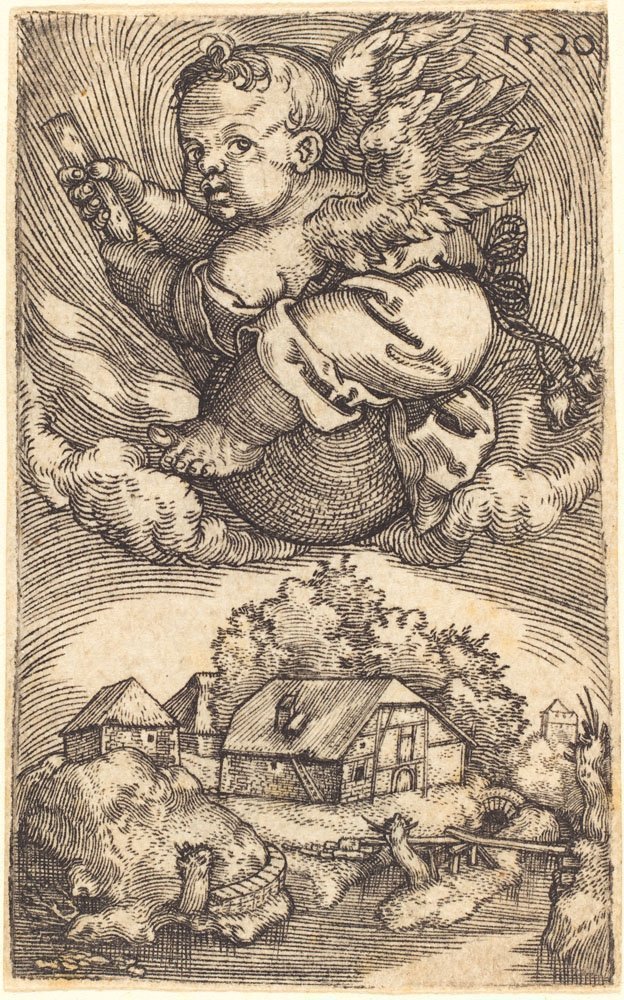The volumes 106-109 of Hollstein's German series are dedicated to the graphic œuvre of Heinrich Vogtherr the Elder.
Heinrich Vogtherr the Elder was in some ways a remarkable figure in a troubled era. Born in 1490 in Dillingen on the Danube river as the son of a medic, he practiced medicine himself and nonetheless was also trained as a painter, possibly by the famous Hans Burgkmair the Elder in Augsburg. As a journeyman he worked in Erfurt, Leipzig and other places before returning to Augsburg in 1518 where he set up shop as a publisher. As such he strongly supported Luther’s teachings. 1522-1525 he was busy decorating the church of Wimpfen with fresco paintings in a style that followed Albrecht Dürer and Martin Schongauer. He made the acquaintances of certain leaders of the peasant rebels and participated in the failed siege of Zell (Radolfzell). In 1526, having fled with the family to Strasbourg, he acquired citizenship there. He worked as a woodcutter and designer and, in 1536, started his own printing shop publishing exclusively his own writings. His application in 1541 for the permanent position as a secretary (die schreiberei vf dem werckhove) was unsuccesful spurring his production of woodcuts for other publishers in Speyer, Basel and Augsburg. From 1544 to 1546 Vogtherr lived with Christoph Froschauer in Zurich, supplying a number of his publications with illustrations. The crowning moment of his career was the appointment in 1550 to be the „Emperor’s oculist and painter“ in Vienna where he died in 1556. Vogtherr’s prints consist of 38 single sheets, some of a large format printed from several blocks, among which two magnificent maps, some broadsheets and some coats of arms. The single sheet prints are presented in the first volume of this catalogue preceding his book illustrations. Vogtherr appears as an artist of varying ambition and quality. It is quite fascinating to see him producing some of his best work when depicting well known scenes and figures on a small scale in copious illustration series. The passional printed by Johann Miller in Augsburg in 1517-1518 is a case in point and also serves to show that the Lutheran leanings of the printmaker did not prevent him from taking up a catholic commission. The little figures being shown in situations of often similar martyrdom are given in impressively varied depictions. Even more interesting than the almost two-hundred saints of the passional are Vogtherr’s again circa two-hundred illustrations to the old testament of Wolfgang Köpfel’s Strasbourg bible of 1529-1530. They can be rated among the best bible illustrations of their time. Leafing through Vogtherr’s print production, an interesting process of combining older illustration series for new purposes becomes apparent. In other cases prints that obviously belong together only appear in seperate publications suggesting that there either were more books carrying his prints than are known today or that the artist produced series even before receiving a commission. An example are the four evangelists presented with their symbols in beautiful glorioles of light. Matthew, Mark and Luke (nos. 893, 894, 901) can be found in the afore-mentioned bible while John (no. 564) was already used in another book two years before. In the 1529 bible he is represented by a print from another series. Vogtherr also sometimes makes use of a technique that was invented soon after the advent of letter press printing itself and had all but disappeared from book illustration in his time. He simply cut off part of a wood block and added other parts to the surviving piece (nos. 410-411, 897-500) resulting, sometimes to remarkable effect, in further pictures only part of which were new. Among the other prints are a trove of title borders for books and illustrations of the most varied subjects and sizes. The Hollstein volumes on Heinrich Vogtherr the Elder give a particularly comprehensive glimpse into the contemporary visual world apart from and supplementing the high art of his time today mostly presented in museums.
Published in 2024
Compiler: Dieter Beaujean
Editor: Gero Seelig


